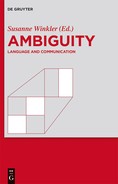Inhaltsverzeichnis
Titel
Impressum
Widmung
Vorwort
Exploring Ambiguity and the Ambiguity Model from a Transdisciplinary Perspective
Impressum
Widmung
Vorwort
Exploring Ambiguity and the Ambiguity Model from a Transdisciplinary Perspective
Part II: (Strategic) Ambiguity in the Production Process
Strategisches Ambiguieren, Verstehenswechsel und rhetorische Textleistung. Am Beispiel von Shakespeares Antony-Rede
1 Rhetorische Voraussetzungen
2 Geheimnis und ambivalente Tat: Zur Vorgeschichte der Antony-Rede
3 Der pragmatische Rahmen der Antony-Rede
4 Disposition der Antony-Rede
5 Ambiguität als intendierte rhetorische Produktivkraft in der Antony-Rede
2 Geheimnis und ambivalente Tat: Zur Vorgeschichte der Antony-Rede
3 Der pragmatische Rahmen der Antony-Rede
4 Disposition der Antony-Rede
5 Ambiguität als intendierte rhetorische Produktivkraft in der Antony-Rede
Ambiguity in Shakespeare’s Sonnet 138
Von der intendierten Ambiguität in die Aporie. Monologische und dialogische Erkenntniswege am Beispiel von PlatonsHippias Minor
Part III: (Strategic) Ambiguity in the Perception Process
Ambiguity and Sentence Position: An Experimental Case Study on Manner Adverbs
Discourse Function Ambiguity of Fragments: A Linguistic Puzzle
Ambiguität und Schriftauslegung: Beobachtungen zu Augustins SchriftDe utilitate credendi
Part IV: (Strategic) Ambiguity in Communicative Interaction
Ambiguity in Speaker-Hearer-Interaction: A Parameter-Based Model of Analysis
1 Introduction
2 Why Ambiguity Is Overrated – and Why It Isn’t: Ambiguity in the Language System vs. Ambiguity in Discourse
3 Approaches to Ambiguity and Paradigms of Ambiguity
2 Why Ambiguity Is Overrated – and Why It Isn’t: Ambiguity in the Language System vs. Ambiguity in Discourse
3 Approaches to Ambiguity and Paradigms of Ambiguity
..................Content has been hidden....................
You can't read the all page of ebook, please click here login for view all page.
